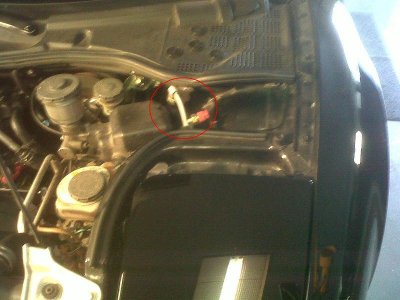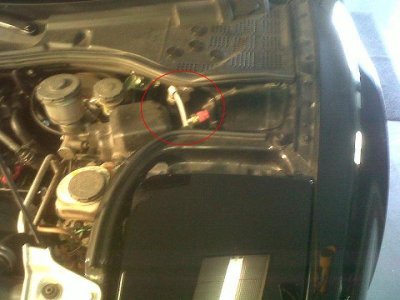About two weeks ago, due to intermittant ac, I took my car to a shop. My independent mechanic suspected a sticking expansion valve and said I should get a second/expert opinion. Acura said same thing...$1200 to fix (removing dash).
I did the expansion valve through the fire wall method and refilled with 134a.
It blew cool for a little while then stopped and then blew cold again (much like a sticking expansion valve???).
I have noticed that the tube (circled below) is extremely cold when the ac is NOT blowing cold and the tube warms up when the system seems to be working fine. ???
Also while diagnosing this issue, I heard what sounded like a hose blow and hissing (with some associated mist (not really smoke) and dust...like a ac hose blew...but I could not trace it (might have even come from the engine compartment, and after I shut down and re-started, the ac blew cool??? Is there some sort of over-pressure relief valve that may have popped an reset once over pressure was reduced?
But ac remains intermitant and the sight glass on top of the dryer seems to indicate air in the system??? I have tried to continue to fill with 134a...but it should be overfilled by now.
Thanks
I did the expansion valve through the fire wall method and refilled with 134a.
It blew cool for a little while then stopped and then blew cold again (much like a sticking expansion valve???).
I have noticed that the tube (circled below) is extremely cold when the ac is NOT blowing cold and the tube warms up when the system seems to be working fine. ???
Also while diagnosing this issue, I heard what sounded like a hose blow and hissing (with some associated mist (not really smoke) and dust...like a ac hose blew...but I could not trace it (might have even come from the engine compartment, and after I shut down and re-started, the ac blew cool??? Is there some sort of over-pressure relief valve that may have popped an reset once over pressure was reduced?
But ac remains intermitant and the sight glass on top of the dryer seems to indicate air in the system??? I have tried to continue to fill with 134a...but it should be overfilled by now.
Thanks
Attachments
Last edited:







